Pumping Station Desing - Second Edition by Robert L. Sanks, George Tchobahoglous, Garr M. Jones
Подождите немного. Документ загружается.

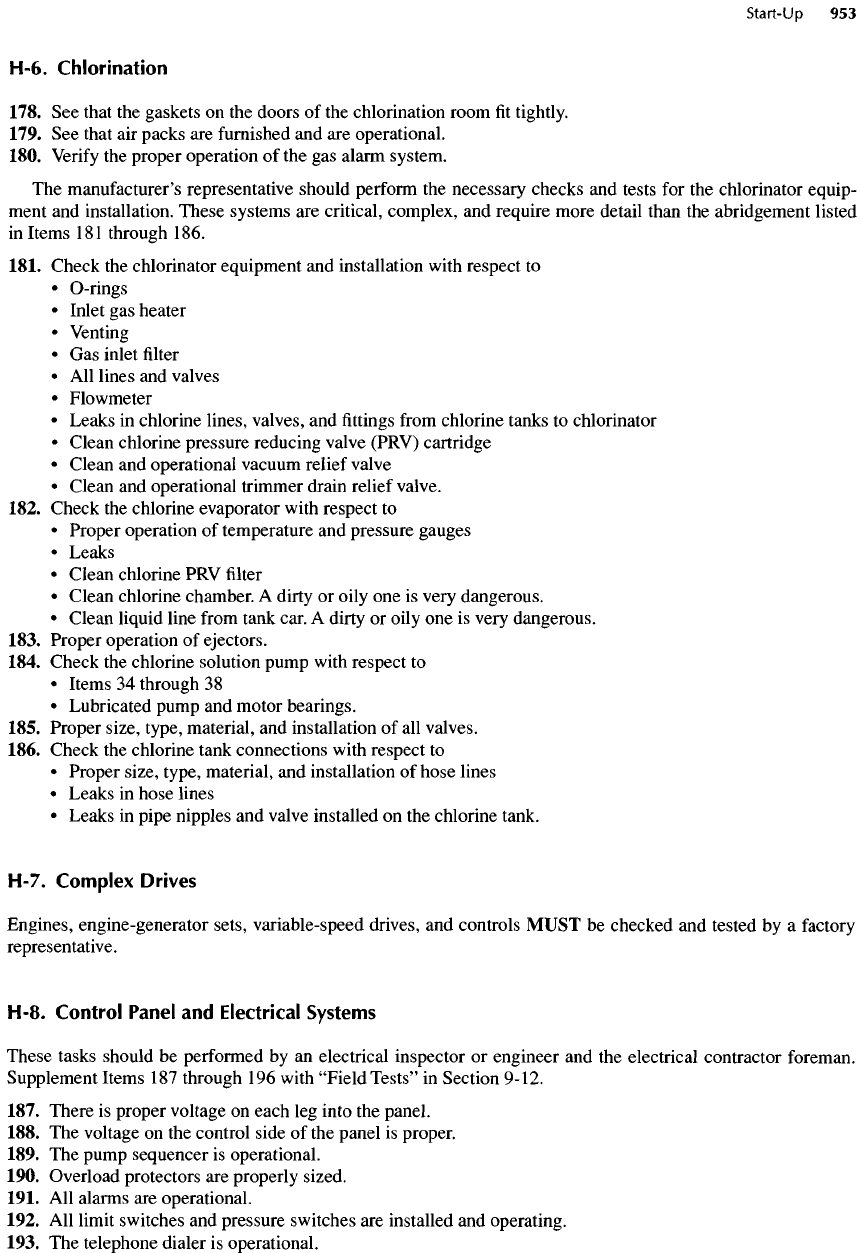
H-6. Chlorination
178.
See
that
the
gaskets
on the
doors
of the
chlorination room
fit
tightly.
179.
See
that
air
packs
are
furnished
and are
operational.
180.
Verify
the
proper operation
of the gas
alarm system.
The
manufacturer's representative should perform
the
necessary checks
and
tests
for the
chlorinator
equip-
ment
and
installation.
These
systems
are
critical, complex,
and
require more detail than
the
abridgement listed
in
Items
181
through 186.
181. Check
the
chlorinator equipment
and
installation with respect
to
•
O-rings
•
Inlet
gas
heater
•
Venting
• Gas
inlet
filter
• All
lines
and
valves
•
Flowmeter
•
Leaks
in
chlorine lines, valves,
and fittings
from
chlorine tanks
to
chlorinator
•
Clean chlorine pressure reducing valve (PRV) cartridge
•
Clean
and
operational vacuum relief valve
•
Clean
and
operational trimmer drain relief valve.
182. Check
the
chlorine evaporator
with
respect
to
•
Proper operation
of
temperature
and
pressure gauges
•
Leaks
•
Clean chlorine
PRV filter
•
Clean chlorine chamber.
A
dirty
or
oily
one is
very dangerous.
•
Clean liquid line
from
tank car.
A
dirty
or
oily
one is
very dangerous.
183. Proper operation
of
ejectors.
184. Check
the
chlorine solution pump
with
respect
to
•
Items
34
through
38
•
Lubricated pump
and
motor bearings.
185. Proper size, type, material,
and
installation
of all
valves.
186. Check
the
chlorine tank connections
with
respect
to
•
Proper size, type, material,
and
installation
of
hose lines
•
Leaks
in
hose lines
•
Leaks
in
pipe nipples
and
valve installed
on the
chlorine tank.
H-7. Complex Drives
Engines,
engine-generator sets, variable-speed drives,
and
controls MUST
be
checked
and
tested
by a
factory
representative.
H-8. Control Panel
and
Electrical
Systems
These tasks should
be
performed
by an
electrical
inspector
or
engineer
and the
electrical contractor foreman.
Supplement
Items
187
through
196
with
"Field
Tests"
in
Section
9-12.
187. There
is
proper voltage
on
each
leg
into
the
panel.
188.
The
voltage
on the
control side
of the
panel
is
proper.
189.
The
pump sequencer
is
operational.
190. Overload protectors
are
properly sized.
191.
All
alarms
are
operational.
192.
All
limit switches
and
pressure switches
are
installed
and
operating.
193.
The
telephone dialer
is
operational.
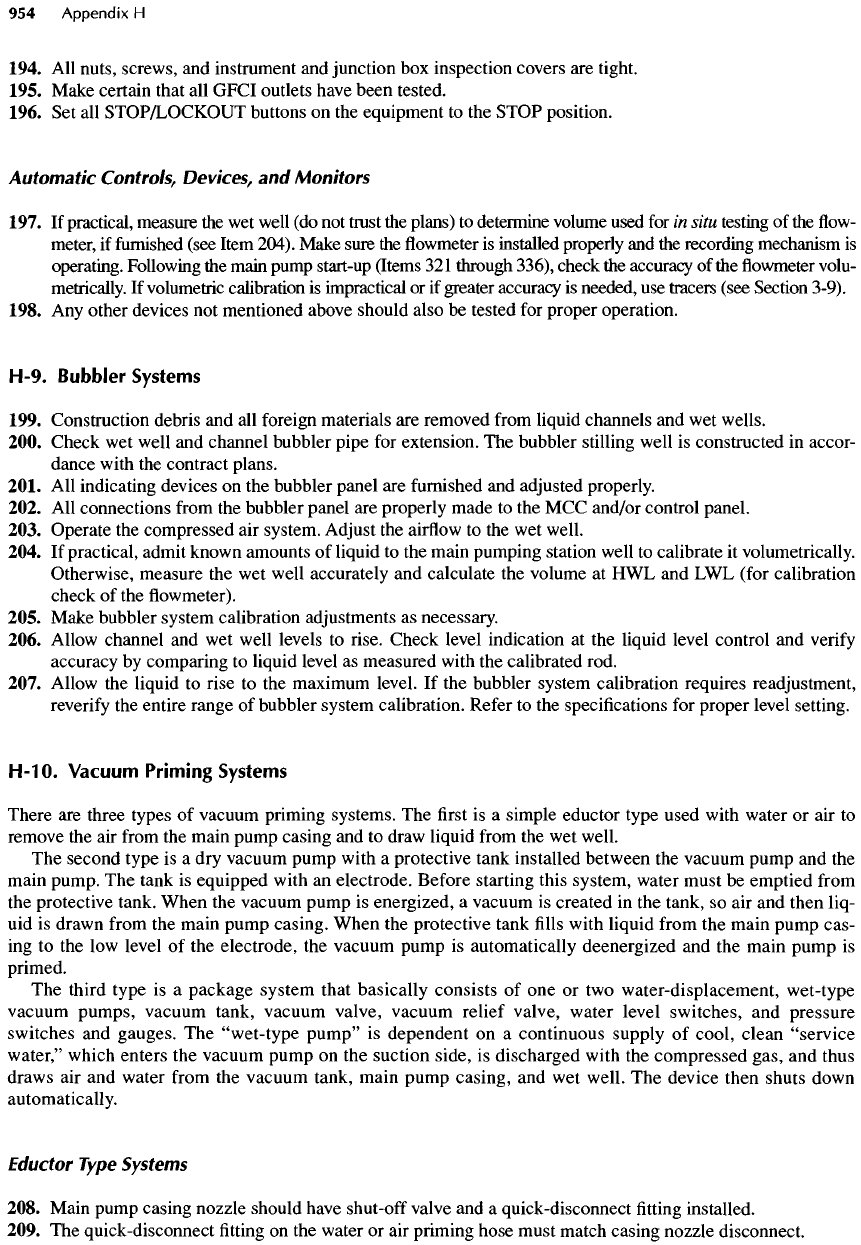
194.
All
nuts, screws,
and
instrument
and
junction
box
inspection covers
are
tight.
195. Make certain that
all
GFCI outlets have been tested.
196.
Set all
STOP/LOCKOUT
buttons
on the
equipment
to the
STOP
position.
Automatic
Controls,
Devices,
and
Monitors
197.
If
practical, measure
the wet
well
(do not
trust
the
plans)
to
determine volume used
for in
situ
testing
of the flow-
meter,
if
furnished
(see Item 204). Make sure
the flowmeter is
installed properly
and the
recording mechanism
is
operating. Following
the
main pump start-up (Items
321
through 336), check
the
accuracy
of the
flowmeter
volu-
metrically.
If
volumetric calibration
is
impractical
or if
greater accuracy
is
needed,
use
tracers (see Section 3-9).
198.
Any
other devices
not
mentioned above should also
be
tested
for
proper operation.
H-9. Bubbler
Systems
199. Construction debris
and all
foreign materials
are
removed
from
liquid channels
and wet
wells.
200. Check
wet
well
and
channel bubbler pipe
for
extension.
The
bubbler stilling well
is
constructed
in
accor-
dance with
the
contract plans.
201.
All
indicating devices
on the
bubbler panel
are
furnished
and
adjusted properly.
202.
All
connections
from
the
bubbler panel
are
properly made
to the MCC
and/or control panel.
203. Operate
the
compressed
air
system.
Adjust
the
airflow
to the wet
well.
204.
If
practical, admit known amounts
of
liquid
to the
main pumping station well
to
calibrate
it
volumetrically.
Otherwise, measure
the wet
well accurately
and
calculate
the
volume
at HWL and LWL
(for calibration
check
of the flowmeter).
205. Make bubbler system calibration adjustments
as
necessary.
206. Allow channel
and wet
well levels
to
rise. Check level indication
at the
liquid level control
and
verify
accuracy
by
comparing
to
liquid level
as
measured with
the
calibrated rod.
207. Allow
the
liquid
to
rise
to the
maximum level.
If the
bubbler system calibration requires readjustment,
reverify
the
entire range
of
bubbler system calibration.
Refer
to the
specifications
for
proper level setting.
H-10.
Vacuum Priming
Systems
There
are
three types
of
vacuum priming systems.
The first is a
simple eductor type used with water
or air to
remove
the air
from
the
main pump casing
and to
draw liquid
from
the wet
well.
The
second type
is a dry
vacuum pump with
a
protective tank installed between
the
vacuum pump
and the
main
pump.
The
tank
is
equipped with
an
electrode. Before starting this system, water must
be
emptied
from
the
protective tank. When
the
vacuum pump
is
energized,
a
vacuum
is
created
in the
tank,
so air and
then liq-
uid
is
drawn
from
the
main pump casing. When
the
protective tank
fills
with liquid
from
the
main pump cas-
ing
to the low
level
of the
electrode,
the
vacuum pump
is
automatically deenergized
and the
main pump
is
primed.
The
third type
is a
package system that basically consists
of one or two
water-displacement, wet-type
vacuum
pumps, vacuum tank, vacuum valve, vacuum relief valve, water level switches,
and
pressure
switches
and
gauges.
The
"wet-type pump"
is
dependent
on a
continuous supply
of
cool, clean
"service
water," which enters
the
vacuum pump
on the
suction
side,
is
discharged with
the
compressed gas,
and
thus
draws
air and
water
from
the
vacuum tank, main pump casing,
and wet
well.
The
device then shuts down
automatically.
Eductor
Type
Systems
208. Main pump casing nozzle should have
shut-off
valve
and a
quick-disconnect
fitting
installed.
209.
The
quick-disconnect
fitting on the
water
or air
priming hose must match casing nozzle disconnect.
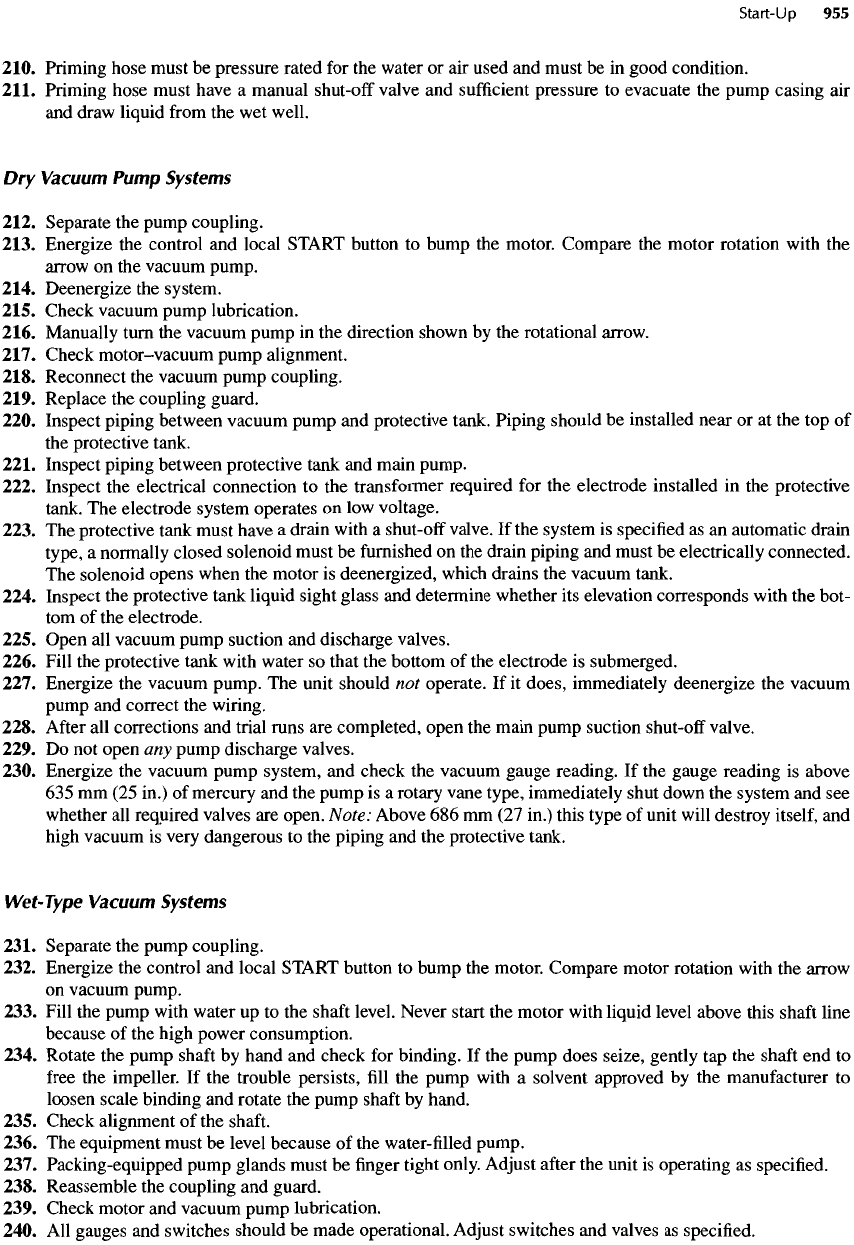
210. Priming hose must
be
pressure rated
for the
water
or air
used
and
must
be in
good condition.
211. Priming hose must have
a
manual
shut-off
valve
and
sufficient
pressure
to
evacuate
the
pump casing
air
and
draw liquid
from
the wet
well.
Dry
Vacuum
Pump
Systems
212. Separate
the
pump coupling.
213. Energize
the
control
and
local START button
to
bump
the
motor. Compare
the
motor rotation with
the
arrow
on the
vacuum pump.
214. Deenergize
the
system.
215. Check vacuum pump lubrication.
216. Manually turn
the
vacuum pump
in the
direction shown
by the
rotational arrow.
217. Check
motor-vacuum
pump alignment.
218. Reconnect
the
vacuum pump coupling.
219. Replace
the
coupling guard.
220. Inspect piping between vacuum pump
and
protective tank. Piping should
be
installed near
or at the top of
the
protective tank.
221. Inspect piping between protective tank
and
main pump.
222. Inspect
the
electrical connection
to the
transformer required
for the
electrode
installed
in the
protective
tank.
The
electrode system operates
on low
voltage.
223.
The
protective tank must have
a
drain with
a
shut-off
valve.
If the
system
is
specified
as an
automatic drain
type,
a
normally closed solenoid must
be
furnished
on the
drain piping
and
must
be
electrically connected.
The
solenoid opens when
the
motor
is
deenergized, which drains
the
vacuum tank.
224. Inspect
the
protective tank liquid sight glass
and
determine whether
its
elevation corresponds with
the
bot-
tom
of the
electrode.
225. Open
all
vacuum pump suction
and
discharge valves.
226. Fill
the
protective tank with water
so
that
the
bottom
of the
electrode
is
submerged.
227. Energize
the
vacuum pump.
The
unit should
not
operate.
If it
does, immediately deenergize
the
vacuum
pump
and
correct
the
wiring.
228.
After
all
corrections
and
trial runs
are
completed, open
the
main pump suction
shut-off
valve.
229.
Do not
open
any
pump discharge valves.
230. Energize
the
vacuum pump system,
and
check
the
vacuum gauge reading.
If the
gauge reading
is
above
635 mm (25
in.)
of
mercury
and the
pump
is a
rotary vane type, immediately shut down
the
system
and see
whether
all
required valves
are
open. Note: Above
686 mm (27
in.) this type
of
unit will destroy itself,
and
high
vacuum
is
very dangerous
to the
piping
and the
protective tank.
Wet-Type
Vacuum
Systems
231. Separate
the
pump coupling.
232. Energize
the
control
and
local START button
to
bump
the
motor. Compare motor rotation with
the
arrow
on
vacuum pump.
233. Fill
the
pump with water
up to the
shaft
level. Never start
the
motor with liquid level above this
shaft
line
because
of the
high power consumption.
234. Rotate
the
pump
shaft
by
hand
and
check
for
binding.
If the
pump does seize, gently
tap the
shaft
end to
free
the
impeller.
If the
trouble
persists,
fill the
pump with
a
solvent approved
by the
manufacturer
to
loosen scale binding
and
rotate
the
pump
shaft
by
hand.
235. Check alignment
of the
shaft.
236.
The
equipment must
be
level
because
of the
water-filled pump.
237. Packing-equipped pump glands must
be finger
tight only.
Adjust
after
the
unit
is
operating
as
specified.
238.
Reassemble
the
coupling
and
guard.
239. Check motor
and
vacuum pump lubrication.
240.
All
gauges
and
switches should
be
made operational.
Adjust
switches
and
valves
as
specified.
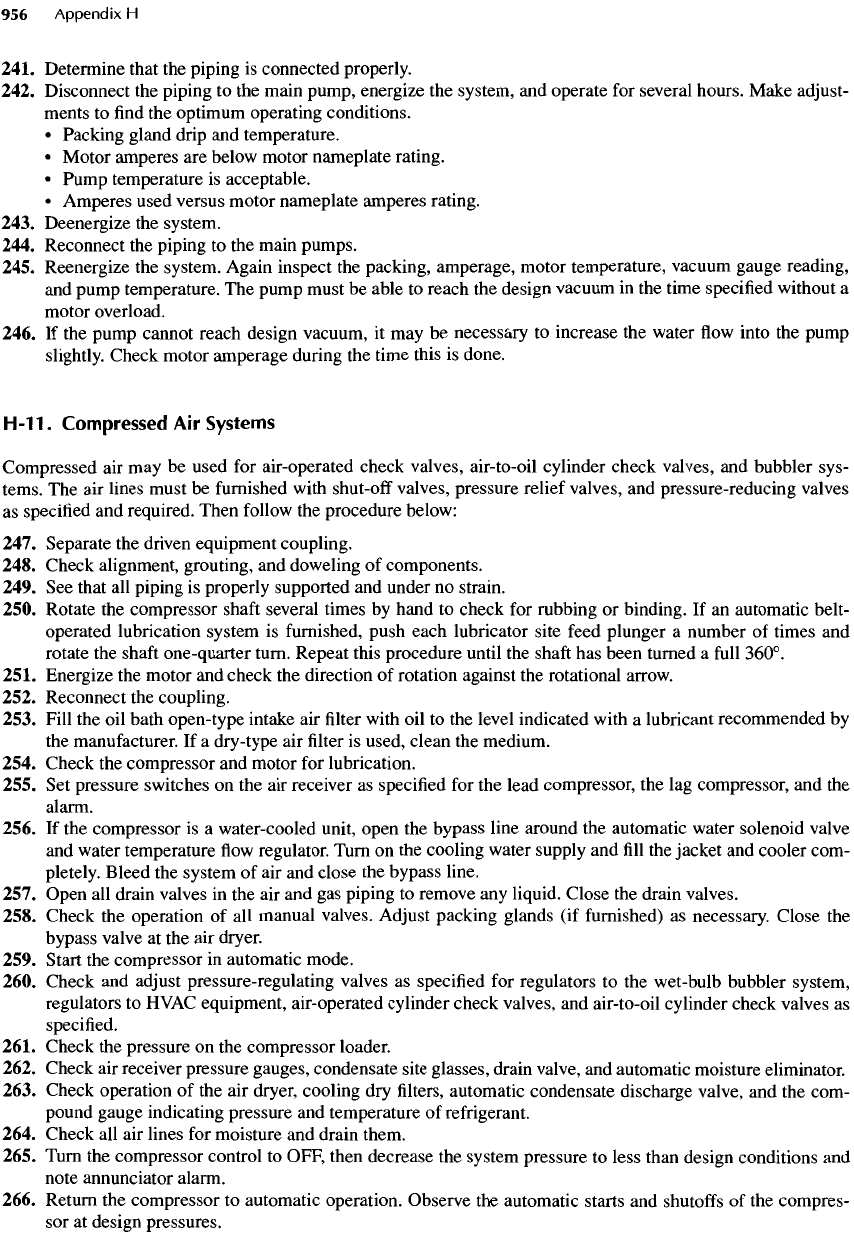
241. Determine that
the
piping
is
connected properly.
242. Disconnect
the
piping
to the
main pump, energize
the
system,
and
operate
for
several hours. Make adjust-
ments
to find the
optimum operating conditions.
•
Packing gland drip
and
temperature.
•
Motor amperes
are
below motor
nameplate
rating.
•
Pump temperature
is
acceptable.
•
Amperes used versus motor nameplate amperes rating.
243. Deenergize
the
system.
244. Reconnect
the
piping
to the
main pumps.
245. Reenergize
the
system. Again inspect
the
packing, amperage, motor temperature, vacuum gauge reading,
and
pump temperature.
The
pump must
be
able
to
reach
the
design vacuum
in the
time specified without
a
motor overload.
246.
If the
pump cannot reach design vacuum,
it may be
necessary
to
increase
the
water
flow
into
the
pump
slightly.
Check motor amperage during
the
time this
is
done.
H-11.
Compressed
Air
Systems
Compressed
air may be
used
for
air-operated check valves, air-to-oil cylinder check valves,
and
bubbler sys-
tems.
The air
lines must
be
furnished
with
shut-off
valves, pressure relief valves,
and
pressure-reducing valves
as
specified
and
required. Then
follow
the
procedure below:
247. Separate
the
driven equipment coupling.
248. Check alignment, grouting,
and
doweling
of
components.
249.
See
that
all
piping
is
properly supported
and
under
no
strain.
250. Rotate
the
compressor
shaft
several times
by
hand
to
check
for
rubbing
or
binding.
If an
automatic belt-
operated lubrication system
is
furnished,
push each lubricator site feed plunger
a
number
of
times
and
rotate
the
shaft
one-quarter turn. Repeat this procedure until
the
shaft
has
been turned
a
full
360°.
251. Energize
the
motor
and
check
the
direction
of
rotation against
the
rotational arrow.
252. Reconnect
the
coupling.
253. Fill
the oil
bath open-type intake
air filter
with
oil to the
level indicated with
a
lubricant recommended
by
the
manufacturer.
If a
dry-type
air filter is
used, clean
the
medium.
254. Check
the
compressor
and
motor
for
lubrication.
255.
Set
pressure switches
on the air
receiver
as
specified
for the
lead compressor,
the lag
compressor,
and the
alarm.
256.
If the
compressor
is a
water-cooled unit, open
the
bypass line around
the
automatic water solenoid valve
and
water temperature
flow
regulator. Turn
on the
cooling water supply
and fill the
jacket
and
cooler com-
pletely. Bleed
the
system
of air and
close
the
bypass line.
257. Open
all
drain valves
in the air and gas
piping
to
remove
any
liquid. Close
the
drain valves.
258. Check
the
operation
of all
manual valves.
Adjust
packing glands
(if
furnished)
as
necessary. Close
the
bypass
valve
at the air
dryer.
259. Start
the
compressor
in
automatic mode.
260. Check
and
adjust
pressure-regulating valves
as
specified
for
regulators
to the
wet-bulb bubbler system,
regulators
to
HVAC
equipment, air-operated cylinder check valves,
and
air-to-oil cylinder check valves
as
specified.
261. Check
the
pressure
on the
compressor loader.
262. Check
air
receiver pressure gauges, condensate site glasses, drain valve,
and
automatic moisture eliminator.
263. Check operation
of the air
dryer, cooling
dry filters,
automatic condensate discharge valve,
and the
com-
pound
gauge indicating pressure
and
temperature
of
refrigerant.
264. Check
all air
lines
for
moisture
and
drain them.
265. Turn
the
compressor control
to
OFF, then decrease
the
system pressure
to
less than design conditions
and
note
annunciator alarm.
266. Return
the
compressor
to
automatic operation. Observe
the
automatic starts
and
shutoffs
of the
compres-
sor at
design pressures.

267.
Check
and
adjust
the
temperature
switches.
The
switches
should
be set at
approximately
6 to
8
0
C
(10 to
15
0
F)
above expected normal operating temperatures.
268. Observe
the
discharge
air
temperature.
It
should
be
approximately equal
to the
expected
discharge temper-
ature
for the
operating pressure
as
shown
on the
manufacturer's data sheet.
269. Observe
the
water outlet temperature
and
wait
for it to
stop rising before making
corrections.
270.
Adjust
water
flow
through
the
aftercooler
(if
installed)
to
maintain approximately
38
0
C
(10O
0
F)
outlet
air
temperature.
271. Reduce
the
pressure
and
note
the
lead
compressor's
automatic start.
272. Reduce
the
pressure
and
note
the lag
compressor's start.
273. Check operation
of the
duty transfer switch.
274.
After
a
unit
has
been operating
for
approximately
2 h,
slowly lower
the
setting
of
each temperature switch
until
the
switch opens
to
shut down
the
driver. Readjust
the
switch
to 6 to
8
0
C
(10 to
15
0
F)
above this shut-
down
point
and
restart
the
unit. Repeat
this
procedure with
each
temperature switch.
275.
After
all the
checks have been made
and the
equipment
is
operating smoothly,
the
unit
is
ready
for
service
in
the
system.
H-12.
Hydropneumatic
Tank
Systems
The
optimum
water-air
ratio
for any
size tank
and
operation condition
can be
found
by
applying Boyle's law,
which
is
expressed mathematically
as
P
1
V
1
=P
2
V
2
(H-I)
where
P is
pressure
and V is
volume.
The
design engineer
has
selected
the
hydropneumatic tank
for a
specific
pressure-level relationship. Obtain
the
information
and be
sure
it is
understood before beginning
a
check
of the
system.
Follow
the
procedure below:
276. Check
the
water receiving tank
and
clean
it.
Flush
the
incoming water lines. Check
the
backflow
preventer.
277. Fill
the
water receiving tank. Check
the
drain,
overflow,
and float-operated fill
valve.
Adjust
as
necessary.
278. Check
the flow-through
chemical feeder
(if
installed)
for
seal-water
treatment.
279. Check
the
duplex strainer,
seal-water
pumps, hydropneumatic tank,
and
main pump
seal-water
piping
and
valves.
280. Check
the
hydropneumatic tank. Flush
the
tank
and
piping with water.
281. Check seal-water pump
and
motor bearing lubrication. Check pump packing.
282. Disengage
the
pump coupling.
283. Energize
the
motor
and
compare
the
direction
of
rotation with rotational arrow
on the
pump.
284. Turn
the
pump
by
hand
in the
direction
of the
arrow
and
check
for
binding.
285. Reconnect
the
pump coupling.
286. Fill
the
hydropneumatic tank
to
specified
maximum water level.
287. Check
the
hydropneumatic tank relief valve against specification (usually factory-set
to
tank pressure
rating).
288. Inspect check valve
and
hydropneumatic tank
air
lines
for
proper
functioning.
Open
air
valve
and
raise
tank
air
pressure
to
maximum operational pressure. Close
air
valve.
289.
Set
pressure switches
as
specified
(by
draining tank)
to:
• Set
automatic-start seal-water pumps
•
Stop seal-water pumps under manual control
• Set
seal-water pressure alarm.
290. Operate seal-water pumps manually
to
check operation.
Refill
the
tank.
291. Override
the
seal pump
and
manual control pressure interlock
by
holding
the
pump start pushbutton. Note
water elevation, operating pressure,
and
annunciator high water alarm.
292. Drain
the
tank
and
note
the
high-water-alarm
clearing level.
293. Place
the
seal-water pump
in
automatic mode. Continue
to
drain
the
tank until
the
lead pump starts. Allow
the
lead pump
to
refill
the
tank. Note pressure
and
level
at
shut-off.
294. Repeat
the
automatic test with
the
second pump
in the
lead position.
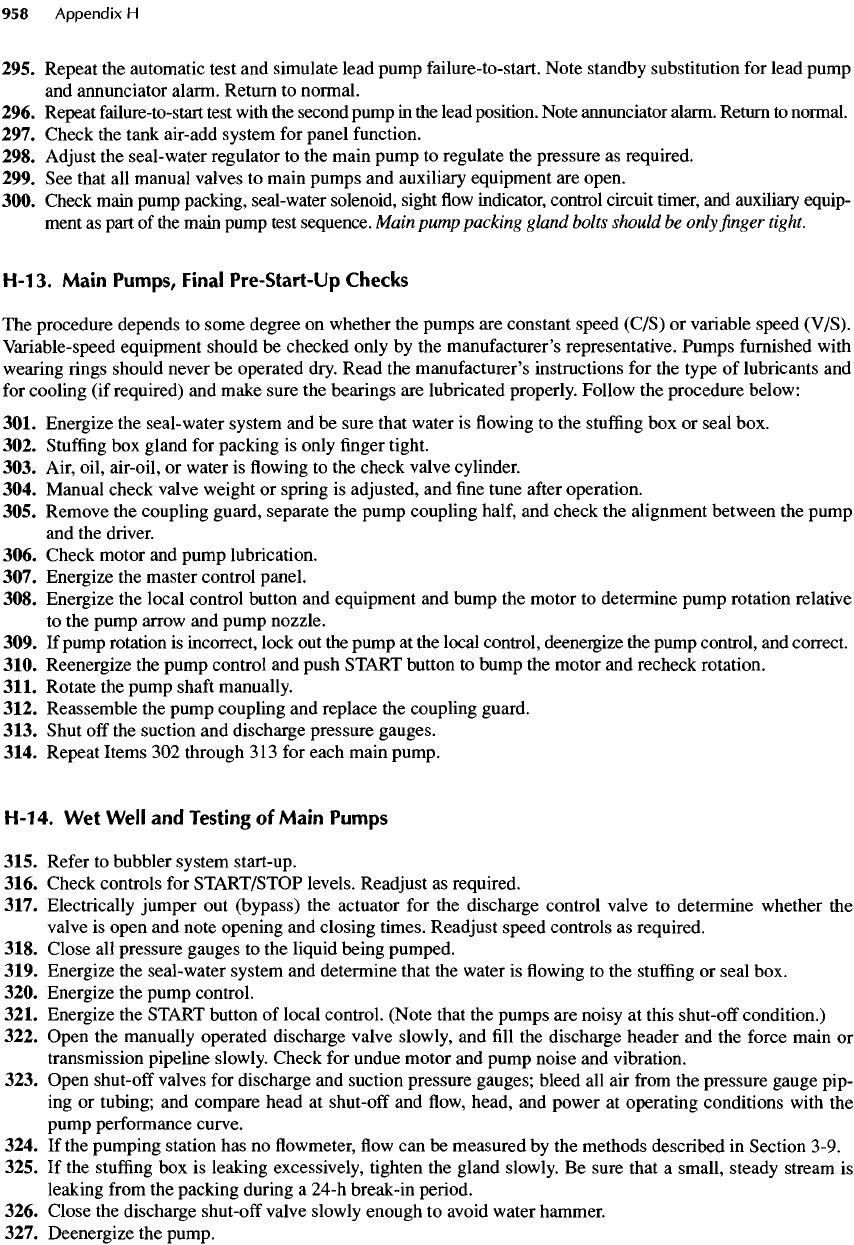
295. Repeat
the
automatic test
and
simulate lead pump failure-to-start. Note standby substitution
for
lead pump
and
annunciator alarm. Return
to
normal.
296. Repeat failure-to-start test with
the
second pump
in the
lead
position.
Note annunciator alarm. Return
to
normal.
297. Check
the
tank air-add system
for
panel
function.
298.
Adjust
the
seal-water regulator
to the
main pump
to
regulate
the
pressure
as
required.
299.
See
that
all
manual valves
to
main pumps
and
auxiliary equipment
are
open.
300. Check main pump packing,
seal-water
solenoid,
sight
flow
indicator, control circuit timer,
and
auxiliary equip-
ment
as
part
of the
main pump test sequence.
Main
pump packing
gland
bolts
should
be
only
finger
tight.
H-13.
Main
Pumps, Final Pre-Start-Up Checks
The
procedure depends
to
some
degree
on
whether
the
pumps
are
constant speed (C/S)
or
variable speed
(V/S).
Variable-speed equipment should
be
checked only
by the
manufacturer's representative. Pumps
furnished
with
wearing rings should never
be
operated dry. Read
the
manufacturer's instructions
for the
type
of
lubricants
and
for
cooling
(if
required)
and
make sure
the
bearings
are
lubricated properly. Follow
the
procedure below:
301. Energize
the
seal-water system
and be
sure that water
is flowing to the
stuffing
box or
seal box.
302.
Stuffing
box
gland
for
packing
is
only
finger
tight.
303. Air, oil, air-oil,
or
water
is flowing to the
check valve cylinder.
304. Manual check valve weight
or
spring
is
adjusted,
and fine
tune
after
operation.
305. Remove
the
coupling guard, separate
the
pump coupling
half,
and
check
the
alignment between
the
pump
and
the
driver.
306. Check motor
and
pump lubrication.
307. Energize
the
master control panel.
308. Energize
the
local control button
and
equipment
and
bump
the
motor
to
determine pump rotation relative
to the
pump arrow
and
pump nozzle.
309.
If
pump rotation
is
incorrect, lock
out the
pump
at the
local control, deenergize
the
pump control,
and
correct.
310. Reenergize
the
pump control
and
push START button
to
bump
the
motor
and
recheck rotation.
311. Rotate
the
pump
shaft
manually.
312. Reassemble
the
pump coupling
and
replace
the
coupling guard.
313. Shut
off
the
suction
and
discharge pressure gauges.
314. Repeat Items
302
through
313
for
each main pump.
H-14.
Wet
Well
and
Testing
of
Main
Pumps
315.
Refer
to
bubbler system start-up.
316. Check controls
for
START/STOP levels. Readjust
as
required.
317. Electrically jumper
out
(bypass)
the
actuator
for the
discharge control valve
to
determine whether
the
valve
is
open
and
note opening
and
closing times. Readjust speed controls
as
required.
318. Close
all
pressure gauges
to the
liquid being pumped.
319. Energize
the
seal-water system
and
determine that
the
water
is flowing to the
stuffing
or
seal box.
320. Energize
the
pump control.
321. Energize
the
START button
of
local control. (Note that
the
pumps
are
noisy
at
this
shut-off
condition.)
322. Open
the
manually operated discharge valve slowly,
and fill the
discharge header
and the
force main
or
transmission pipeline slowly. Check
for
undue motor
and
pump noise
and
vibration.
323. Open
shut-off
valves
for
discharge
and
suction pressure gauges; bleed
all air
from
the
pressure gauge pip-
ing
or
tubing;
and
compare head
at
shut-off
and flow,
head,
and
power
at
operating conditions with
the
pump
performance curve.
324.
If the
pumping station
has no flowmeter, flow can be
measured
by the
methods described
in
Section 3-9.
325.
If the
stuffing
box is
leaking excessively, tighten
the
gland slowly.
Be
sure that
a
small, steady stream
is
leaking
from
the
packing during
a
24-h
break-in
period.
326. Close
the
discharge
shut-off
valve slowly enough
to
avoid water hammer.
327. Deenergize
the
pump.
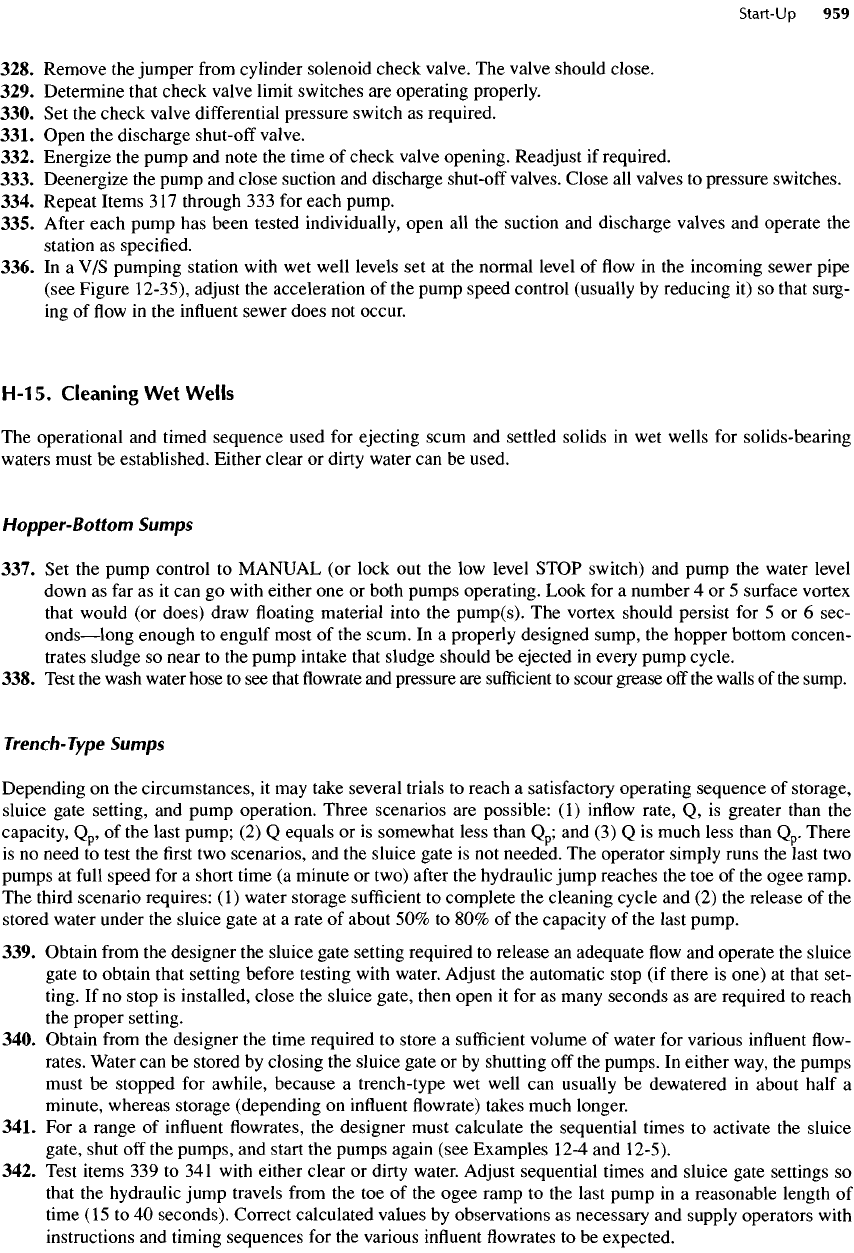
328. Remove
the
jumper
from
cylinder solenoid check valve.
The
valve should
close.
329. Determine that check valve limit switches
are
operating properly.
330.
Set the
check valve
differential
pressure switch
as
required.
331. Open
the
discharge
shut-off
valve.
332. Energize
the
pump
and
note
the
time
of
check valve opening. Readjust
if
required.
333. Deenergize
the
pump
and
close
suction
and
discharge
shut-off
valves. Close
all
valves
to
pressure switches.
334. Repeat Items
317
through
333
for
each pump.
335.
After
each pump
has
been tested individually, open
all the
suction
and
discharge valves
and
operate
the
station
as
specified.
336.
In a V/S
pumping station with
wet
well levels
set at the
normal level
of flow in the
incoming sewer pipe
(see Figure
12-35),
adjust
the
acceleration
of the
pump speed control (usually
by
reducing
it) so
that surg-
ing
of flow in the
influent
sewer does
not
occur.
H-15.
Cleaning
Wet
Wells
The
operational
and
timed sequence used
for
ejecting scum
and
settled solids
in wet
wells
for
solids-bearing
waters must
be
established. Either clear
or
dirty water
can be
used.
Hopper-Bottom
Sumps
337.
Set the
pump control
to
MANUAL
(or
lock
out the low
level
STOP
switch)
and
pump
the
water level
down
as far as it can go
with either
one or
both pumps operating. Look
for a
number
4 or 5
surface vortex
that
would
(or
does) draw
floating
material into
the
pump(s).
The
vortex should persist
for 5 or 6
sec-
onds—long
enough
to
engulf most
of the
scum.
In a
properly designed sump,
the
hopper bottom concen-
trates sludge
so
near
to the
pump intake that sludge should
be
ejected
in
every pump cycle.
338. Test
the
wash water hose
to see
that
flowrate and
pressure
are
sufficient
to
scour grease
off
the
walls
of the
sump.
Trench-Type
Sumps
Depending
on the
circumstances,
it may
take several trials
to
reach
a
satisfactory operating sequence
of
storage,
sluice
gate setting,
and
pump operation. Three scenarios
are
possible:
(1)
inflow
rate,
Q, is
greater than
the
capacity,
Q
p
,
of the
last pump;
(2) Q
equals
or is
somewhat less than
Q
p
;
and (3) Q is
much less than
Q
p
.
There
is
no
need
to
test
the first two
scenarios,
and the
sluice gate
is not
needed.
The
operator simply runs
the
last
two
pumps
at
full
speed
for a
short time
(a
minute
or
two)
after
the
hydraulic jump reaches
the toe of the
ogee ramp.
The
third
scenario requires:
(1)
water storage
sufficient
to
complete
the
cleaning cycle
and (2) the
release
of the
stored water under
the
sluice gate
at a
rate
of
about
50% to 80% of the
capacity
of the
last pump.
339. Obtain
from
the
designer
the
sluice gate setting required
to
release
an
adequate
flow and
operate
the
sluice
gate
to
obtain that setting before testing with water.
Adjust
the
automatic stop
(if
there
is
one)
at
that set-
ting.
If no
stop
is
installed, close
the
sluice gate, then open
it for as
many seconds
as are
required
to
reach
the
proper setting.
340. Obtain
from
the
designer
the
time required
to
store
a
sufficient
volume
of
water
for
various
influent
flow-
rates. Water
can be
stored
by
closing
the
sluice gate
or by
shutting
off the
pumps.
In
either way,
the
pumps
must
be
stopped
for
awhile, because
a
trench-type
wet
well
can
usually
be
dewatered
in
about half
a
minute,
whereas storage (depending
on
influent
flowrate)
takes much longer.
341.
For a
range
of
influent
flowrates, the
designer must calculate
the
sequential times
to
activate
the
sluice
gate, shut
off the
pumps,
and
start
the
pumps again (see Examples 12-4
and
12-5).
342. Test items
339 to 341
with
either clear
or
dirty water.
Adjust
sequential times
and
sluice gate settings
so
that
the
hydraulic jump travels
from
the toe of the
ogee ramp
to the
last pump
in a
reasonable length
of
time
(15
to 40
seconds). Correct calculated values
by
observations
as
necessary
and
supply operators with
instructions
and
timing sequences
for the
various
influent
flowrates to be
expected.
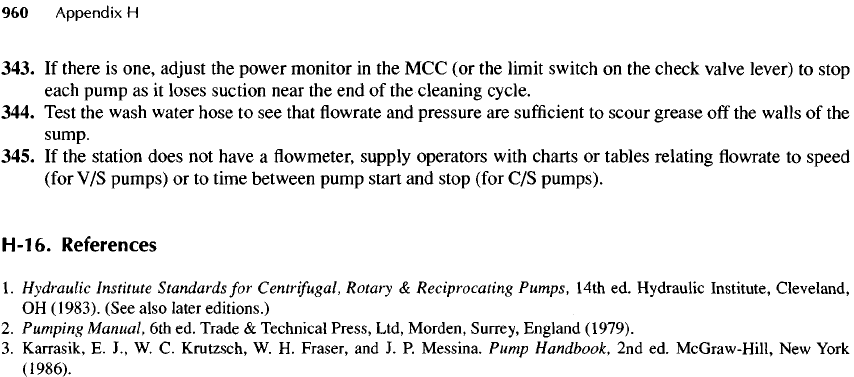
343.
If
there
is
one, adjust
the
power monitor
in the MCC (or the
limit switch
on the
check valve lever)
to
stop
each pump
as it
loses
suction near
the end of the
cleaning cycle.
344. Test
the
wash water hose
to see
that
flowrate and
pressure
are
sufficient
to
scour grease
off the
walls
of the
sump.
345.
If the
station
does
not
have
a flowmeter,
supply operators with charts
or
tables relating
flowrate to
speed
(for
V/S
pumps)
or to
time between pump start
and
stop (for
C/S
pumps).
H-16.
References
1.
Hydraulic
Institute Standards
for
Centrifugal,
Rotary
&
Reciprocating Pumps, 14th
ed.
Hydraulic Institute, Cleveland,
OH
(1983).
(See also later editions.)
2.
Pumping Manual,
6th ed.
Trade
&
Technical Press, Ltd, Morden, Surrey, England
(1979).
3.
Karrasik,
E.
J.,
W. C.
Krutzsch,
W. H.
Eraser,
and J. P.
Messina. Pump Handbook,
2nd ed.
McGraw-Hill,
New
York
(1986).
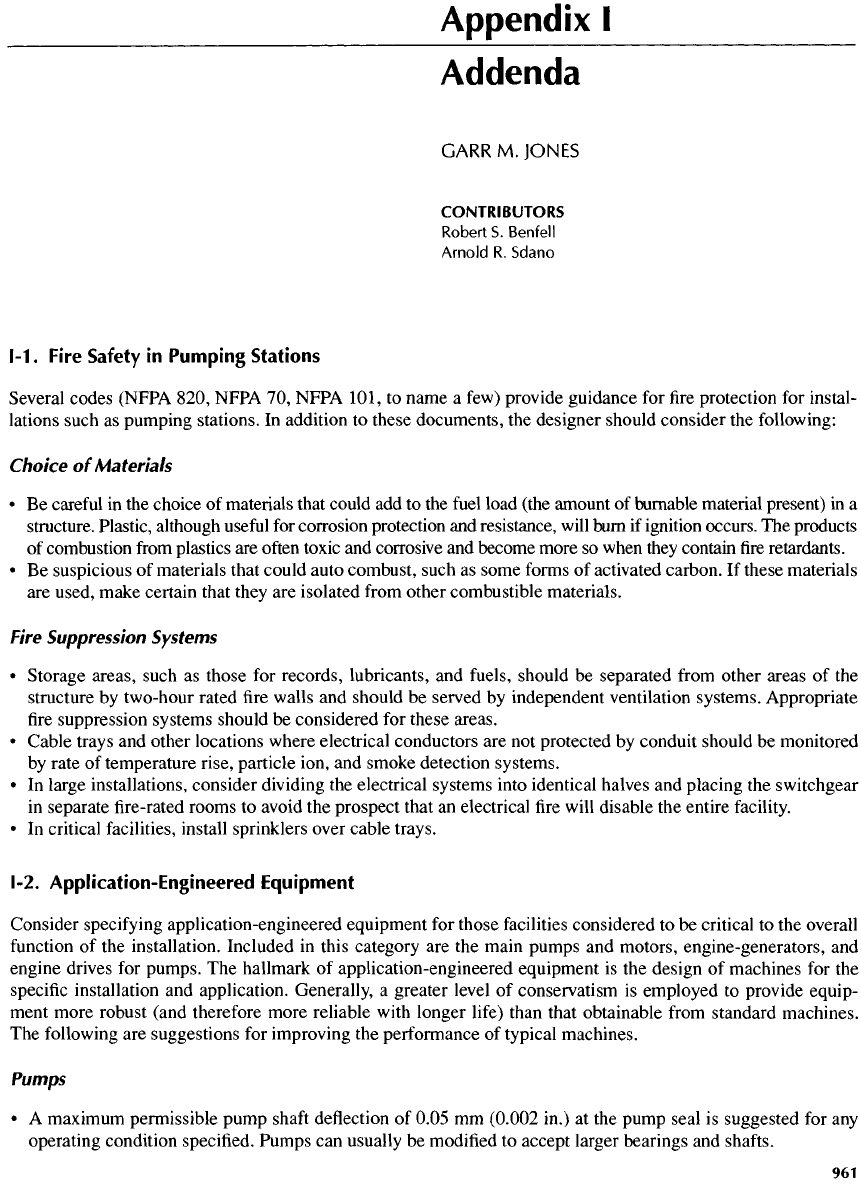
Appendix
I
Addenda
GARR
M.
JONES
CONTRIBUTORS
Roberts.
Benfell
Arnold
R.
Sdano
1-1.
Fire
Safety
in
Pumping Stations
Several codes (NFPA
820,
NFPA
70,
NFPA
101,
to
name
a
few) provide guidance
for fire
protection
for
instal-
lations such
as
pumping stations.
In
addition
to
these
documents,
the
designer should
consider
the
following:
Choice
of
Materials
• Be
careful
in the
choice
of
materials that could
add to the
fuel
load
(the
amount
of
burnable material present)
in a
structure.
Plastic, although
useful
for
corrosion protection
and
resistance, will
burn
if
ignition occurs.
The
products
of
combustion
from
plastics
are
often
toxic
and
corrosive
and
become more
so
when they contain
fire
retardants.
• Be
suspicious
of
materials that could auto combust, such
as
some forms
of
activated carbon.
If
these materials
are
used, make certain that they
are
isolated
from
other combustible materials.
Fire
Suppression
Systems
•
Storage areas, such
as
those
for
records, lubricants,
and
fuels,
should
be
separated
from
other areas
of the
structure
by
two-hour rated
fire
walls
and
should
be
served
by
independent ventilation systems. Appropriate
fire
suppression systems should
be
considered
for
these areas.
•
Cable trays
and
other locations where electrical conductors
are not
protected
by
conduit should
be
monitored
by
rate
of
temperature rise, particle
ion,
and
smoke detection systems.
• In
large installations, consider dividing
the
electrical systems into identical halves
and
placing
the
switchgear
in
separate
fire-rated
rooms
to
avoid
the
prospect
that
an
electrical
fire
will disable
the
entire facility.
• In
critical
facilities,
install sprinklers over cable trays.
1-2.
Application-Engineered Equipment
Consider
specifying
application-engineered equipment
for
those facilities considered
to be
critical
to the
overall
function
of the
installation. Included
in
this category
are the
main pumps
and
motors, engine-generators,
and
engine drives
for
pumps.
The
hallmark
of
application-engineered equipment
is the
design
of
machines
for the
specific
installation
and
application. Generally,
a
greater level
of
conservatism
is
employed
to
provide equip-
ment
more robust
(and
therefore more reliable with longer
life)
than that obtainable
from
standard machines.
The
following
are
suggestions
for
improving
the
performance
of
typical machines.
Pumps
• A
maximum permissible pump
shaft
deflection
of
0.05
mm
(0.002
in.)
at the
pump seal
is
suggested
for any
operating
condition
specified.
Pumps
can
usually
be
modified
to
accept larger bearings
and
shafts.
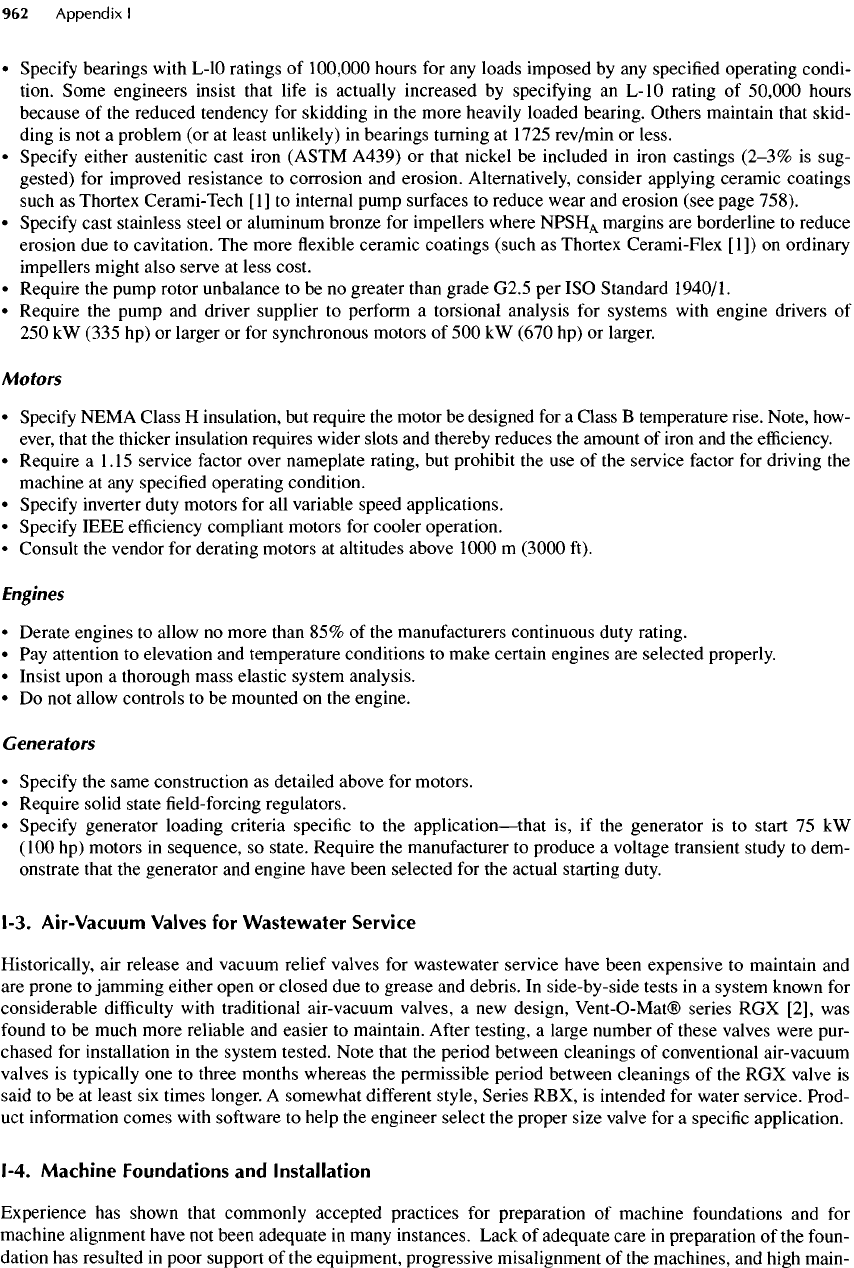
•
Specify bearings with
L-IO
ratings
of
100,000
hours
for any
loads imposed
by any
specified operating condi-
tion. Some engineers insist that
life
is
actually increased
by
specifying
an
L-IO
rating
of
50,000
hours
because
of the
reduced tendency
for
skidding
in the
more heavily loaded bearing. Others maintain that skid-
ding
is not a
problem
(or at
least unlikely)
in
bearings turning
at
1725
rev/min
or
less.
•
Specify
either austenitic cast iron (ASTM A439)
or
that nickel
be
included
in
iron castings (2-3%
is
sug-
gested)
for
improved resistance
to
corrosion
and
erosion.
Alternatively, consider applying ceramic coatings
such
as
Thortex
Cerami-Tech
[1]
to
internal pump surfaces
to
reduce wear
and
erosion (see page 758).
•
Specify cast stainless steel
or
aluminum bronze
for
impellers where
NPSH
A
margins
are
borderline
to
reduce
erosion
due to
cavitation.
The
more
flexible
ceramic coatings (such
as
Thortex
Cerami-Flex
[I])
on
ordinary
impellers
might also serve
at
less cost.
•
Require
the
pump rotor unbalance
to be no
greater than grade G2.5
per ISO
Standard
1940/1.
•
Require
the
pump
and
driver supplier
to
perform
a
torsional analysis
for
systems with engine drivers
of
250 kW
(335
hp) or
larger
or for
synchronous motors
of 500 kW
(670
hp) or
larger.
Motors
•
Specify
NEMA Class
H
insulation,
but
require
the
motor
be
designed
for a
Class
B
temperature rise. Note, how-
ever, that
the
thicker insulation requires wider slots
and
thereby
reduces
the
amount
of
iron
and the
efficiency.
•
Require
a
1.15
service factor over nameplate rating,
but
prohibit
the use of the
service factor
for
driving
the
machine
at any
specified operating condition.
•
Specify inverter
duty
motors
for all
variable speed applications.
•
Specify
IEEE
efficiency
compliant motors
for
cooler
operation.
•
Consult
the
vendor
for
derating motors
at
altitudes above 1000
m
(3000
ft).
Engines
•
Derate engines
to
allow
no
more than
85% of the
manufacturers
continuous duty rating.
• Pay
attention
to
elevation
and
temperature conditions
to
make certain engines
are
selected
properly.
•
Insist upon
a
thorough mass elastic system analysis.
• Do not
allow controls
to be
mounted
on the
engine.
Generators
•
Specify
the
same construction
as
detailed above
for
motors.
•
Require solid state
field-forcing
regulators.
•
Specify generator loading criteria specific
to the
application—that
is, if the
generator
is to
start
75 kW
(100
hp)
motors
in
sequence,
so
state. Require
the
manufacturer
to
produce
a
voltage transient study
to
dem-
onstrate that
the
generator
and
engine have been selected
for the
actual starting duty.
1-3.
Air-Vacuum Valves
for
Wastewater Service
Historically,
air
release
and
vacuum relief valves
for
wastewater service have been expensive
to
maintain
and
are
prone
to
jamming either open
or
closed
due to
grease
and
debris.
In
side-by-side tests
in a
system known
for
considerable
difficulty
with
traditional
air-vacuum
valves,
a new
design, Vent-O-Mat®
series
RGX
[2],
was
found
to be
much more reliable
and
easier
to
maintain.
After
testing,
a
large number
of
these valves were pur-
chased
for
installation
in the
system tested. Note that
the
period between cleanings
of
conventional
air-vacuum
valves
is
typically
one to
three months whereas
the
permissible period between cleanings
of the RGX
valve
is
said
to be at
least
six
times longer.
A
somewhat
different
style, Series RBX,
is
intended
for
water service.
Prod-
uct
information comes
with
software
to
help
the
engineer select
the
proper size valve
for a
specific application.
1-4.
Machine
Foundations
and
Installation
Experience
has
shown
that
commonly accepted practices
for
preparation
of
machine foundations
and for
machine
alignment have
not
been adequate
in
many instances. Lack
of
adequate
care
in
preparation
of the
foun-
dation
has
resulted
in
poor support
of the
equipment, progressive misalignment
of the
machines,
and
high main-
